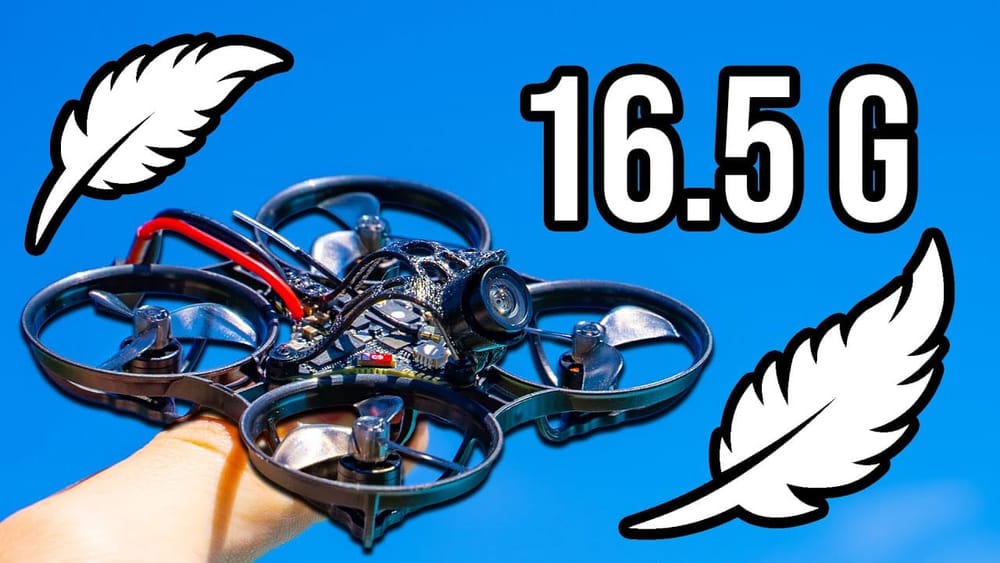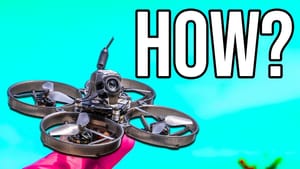
Rimzler’s latest teardown of the Newbeedrone Hummingbird Whoop Race Spec V2 offers a no-nonsense look at one of the lightest 65mm bind-and-fly (BNF) drones on the market. For makers and racers chasing minimal weight and maximum speed, this micro racer's specs and real-world performance matter.

TL;DR
- The Hummingbird RS V2 weighs just 16.5 grams with a stripped-down racing frame.
- Equipped with brushless 0702 30,000KV motors and a custom F4 flight controller with dual 18A ESCs.
- Features an extreme 45°+ camera angle designed for high-speed racing, not freestyle.
- Robust build absorbs crashes well—frame and TPU mounts flex instead of breaking.
- Recommended 300mAh batteries yield around 2 minutes of flight time.
- Best suited for expert pilots or those willing to mod the camera angle for casual flying.
What’s in the Box? Minimalism Meets Racing
The Hummingbird RS V2 arrives with a quick start guide, two extra sets of Azzi tri-blade propellers from Newbeedrone, spare screws, a grommet, and a tool bag. The bag includes a super-light extra canopy, a prop remover branded by Newbeedrone, and a USB-C adapter for flight controller connection.
This is a drone stripped to the essentials. At 65mm and barely 16.5 grams, the frame is skeletal, designed for a razor-thin power-to-weight ratio. Rimzler notes the frame’s springy resilience—something you don’t expect at this scale. The camera mount is TPU and also flexes on impact, reinforcing the drone’s robust build philosophy.

Hardware Breakdown: Tiny but Mighty
Under the hood, the Hummingbird sports brushless 0702 motors spinning at 30,000KV—impressively high for such a tiny package. Motor wires use enameled copper, soldered directly to minuscule pads to shave every possible gram.
The flight controller is custom-built: an all-in-one F4 board with dual-channel 18A ESCs, a rarity in a drone this size. It includes a non-SPI 2.4GHz XpressLRS receiver and a lightweight, crash-resistant red 2.4GHz antenna. A WiFi antenna enables wireless XpressLRS updates—a nice touch for convenience.
The integrated video transmitter (VTX) outputs 25mW by default but can ramp up to 100mW or 400mW. It uses a proprietary SmartMax protocol featuring a temperature sensor that throttles power to prevent board burnout. Notably, the USB port is omitted for weight savings, replaced by a four-pin connector with a dedicated USB-C adapter.

Camera and Battery Setup: Racing Priorities
The analog camera is an 800 TV line Newbeedrone BI unit with a fixed, steep angle—about 45° or more—optimized for racing. Adjusting this angle requires printing a new canopy or mount, which Rimzler suggests is necessary for casual or freestyle flying.
The battery mount is minimalist but functional. It supports 300mAh HV batteries, compatible with 30 or BT2 connectors, and includes reverse polarity protection—a small but essential feature that protects the electronics from user error.

Flight Testing: Silent, Fast, and Extreme
Rimzler tested the drone with two battery types: a 1S 260mAh HV and the recommended 300mAh HV packs. Both delivered roughly two minutes of flight time under racing conditions. The drone is incredibly quiet, a stark contrast to many whoops.
The high camera angle demands high-speed flying to maintain horizon visibility. This drone is not for casual hovering or freestyle tricks—it's built for straight-line racing and aggressive indoor courses.
Bright daylight posed challenges for the analog camera’s dynamic range, making outdoor flying less than ideal, especially in mixed lighting or shaded areas. Despite this, the drone handled light breezes surprisingly well but is best kept indoors or in calm conditions.
Rimzler notes the difficulty of controlling the drone at speed, especially with the steep camera angle. Slowing down to look around is tricky, and spotting obstacles requires skill and experience.

Durability: Bounce, Don’t Break
The drone’s build quality shines in crash tests. Rimzler subjected it to several impacts, including collisions with steel surfaces. The frame and TPU mounts absorb shocks by compressing and springing back, preventing propeller damage and structural failures common in other micro drones.
Even after multiple crashes, the drone remained fully functional with minimal propeller damage—just a slight bend here and there. This resilience makes it a practical choice for backyard racers who want a drone that survives mistakes.

Who Should Buy the Hummingbird RS V2?
This drone targets two groups: expert racers seeking a ready-to-fly, lightweight racer, and beginners interested in learning racing without frequent breakage. Its lightweight construction and robust frame mean less downtime and more practice.
However, it’s not suitable for freestyle pilots or outdoor flying in windy conditions. The steep camera angle severely limits maneuverability and visibility when flying slow or performing tricks. Those wanting a more forgiving camera angle can 3D print a modified canopy or mount, a worthwhile mod for casual flying.
Rimzler plans to experiment with lowering the camera angle via heat adjustment for a more relaxed flying experience.
Final Thoughts
The Newbeedrone Hummingbird Whoop Race Spec V2 stands out as one of the best tiny whoops Rimzler has flown. Its attention to detail, from the SmartMax VTX protocol to the robust frame, sets a high bar for 65mm BNF racers.
While it demands skill due to its extreme camera angle and high-speed nature, it rewards pilots with resilience and performance rarely seen in such a small package. For those wanting a durable, fast, and lightweight racing whoop, the Hummingbird RS V2 is worth considering.
FAQ
What is the weight of the Newbeedrone Hummingbird RS V2?
The drone weighs just 16.5 grams, making it one of the lightest 65mm whoops available.
Can the camera angle be adjusted?
The camera has a fixed, steep angle designed for racing. Adjusting it requires printing a new canopy or camera mount.
What flight time can I expect?
Flight times with recommended 300mAh HV batteries hover around two minutes under racing conditions.
Is this drone suitable for freestyle flying?
No. Its steep camera angle and limited power make it best suited for straight-line racing indoors.
How durable is the frame?
Extremely durable. The springy frame and TPU mounts absorb crashes well, often preventing propeller damage.
Takeaway Box
- Newbeedrone Hummingbird RS V2 weighs a featherlight 16.5 grams with a minimalist racing frame.
- Steep camera angle (~45°+) demands fast flying; not beginner-friendly out of the box.
- Custom F4 flight controller with dual 18A ESCs packs serious punch for its size.
- Robust build survives crashes that would cripple typical tiny whoops.
- Ideal for expert racers or modders willing to tweak camera angle for casual flying.
This article was based from the video The Lightest BNF Racing TinyWhoop! Newbeedrone Hummingbird RS V2




